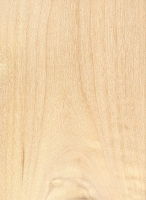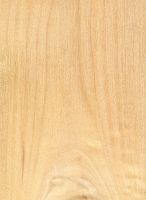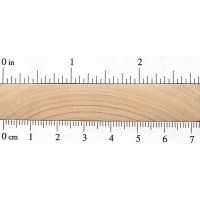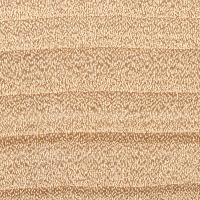 |
Common Name(s): Black Cottonwood Scientific Name: Populus trichocarpa Distribution: Northwestern North America Tree Size: 80-150 ft (25-45 m) tall, 5-6 ft (1.5-2.0 m) trunk diameter Average Dried Weight: 24 lbs/ft3 (385 kg/m3) Specific Gravity (Basic, 12% MC): .31, .38 Janka Hardness: 350 lbf (1,560 N) Modulus of Rupture: 8,500 lbf/in2 (58.6 MPa) Elastic Modulus: 1,270,000 lbf/in2 (8.76 GPa) Crushing Strength: 4,500 lbf/in2 (31.0 MPa) Shrinkage: Radial: 3.6%, Tangential: 8.6%, Volumetric: 12.4%, T/R Ratio: 2.4 |
Color/Appearance: Heartwood tends to be a light brown. Sapwood is a pale yellow to nearly white, and isn’t clearly demarcated, tending to gradually blend into the heartwood.
Grain/Texture: Grain is generally straight to slightly irregular or interlocked. Uniform medium texture with low natural luster.
Endgrain: Diffuse-porous; solitary and radial multiples; medium pores in no specific arrangement, moderately numerous to numerous; parenchyma marginal; narrow rays, spacing fairly close.
Rot Resistance: Rated as non-durable, and also susceptible to insect attack.
Workability: Easy to work with hand and machine tools, though sharp cutters are necessary when planing to avoid fuzzy surfaces, (subsequent fine-sanding may be necessary to obtain a smooth surface). Responds poorly to steam bending. Does not split easily, and has poor nail-holding capability. Wood has a tendency to warp and distort during drying. Glues and finishes well.
Odor: Has a sour odor when green, which disappears once the wood is dry.
Allergies/Toxicity: Besides the standard health risks associated with any type of wood dust, no further health reactions have been associated with Black Cottonwood. See the articles Wood Allergies and Toxicity and Wood Dust Safety for more information.
Pricing/Availability: Cottonwood is generally regarded as low-value wood, and isn’t commonly harvested or available as lumber—though it can usually be found throughout its natural range for utility purposes. Carving blocks or burl blanks are sometimes available for hobbyist purposes. Prices are low for a domestic hardwood.
Sustainability: This wood species is not listed in the CITES Appendices or on the IUCN Red List of Threatened Species.
Common Uses: Boxes/crates, veneer, plywood, and various utility purposes.
Comments: So named for its cotton-like strands that accompany the tree’s seeds in the spring. Black Cottonwood is the largest hardwood tree in western North America.





Black Cottonwood burl is very beautiful! I’ve seen some impressive log cabin style furniture made with it. Even the trunk area can have nice figure. It’s often confused with Balsam Poplar and they can sometimes hybrid. It’s known the dull your tools and blades and planed surfaces are often fuzzy. Warping is bad! This tree often has rot in the heartwood. There’s not a lot of love for cottonwood which is too bad because it can be incredibly beautiful done right.
Here in Washington, it’s also known as pisswood by those unwise enough to burn it.
snylt https://google.com